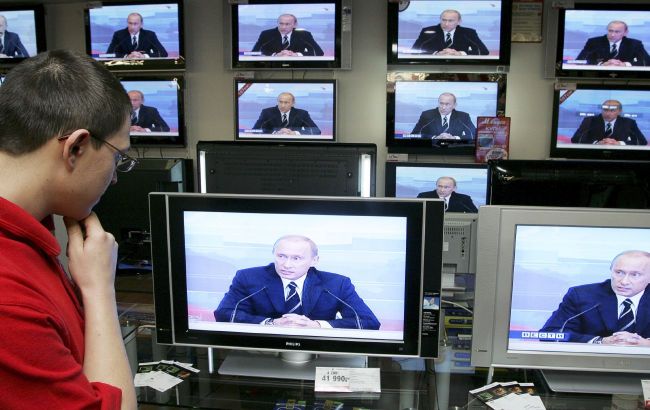Russia’s November propaganda: sanctions, nuclear fears, and claims of Ukrainian 'atrocities'
 Focus of Russian propaganda in November (Illustrative photo: Getty Images)
Focus of Russian propaganda in November (Illustrative photo: Getty Images)
Russian propaganda in the first half of November is expected to focus on campaigns aimed at discrediting EU and US sanctions, as well as issuing new nuclear threats toward Western countries, according to the Center for Countering Disinformation.
EU and US sanctions
Propaganda narratives are likely to intensify, claiming that sanctions have no impact on the Russian economy and only harm Europeans and Americans themselves.
Analysts at the Center believe that the Kremlin’s information response to US sanctions on Rosneft and Lukoil will be twofold: externally, rhetoric will focus on the illegitimacy and ineffectiveness of the sanctions, while domestically, messages will emphasize Russia’s resilience, an economic breakthrough, and another victory over Western attempts to break the country.
Escalation of nuclear threats
An overt campaign of nuclear threats is also expected, promoting the idea of Russia’s alleged unprecedented military advantage, particularly through its nuclear triad.
Through this approach, Russia aims to instill in Western societies the notion that any escalation of the conflict could spiral into a global catastrophe if the West continues supplying weapons to Ukraine. The primary target audience of this campaign is citizens of Western countries.
Disruption of Russia–US talks
The Center also predicts an uptick in campaigns accusing the EU and US of sabotaging peace negotiations. The central claim: the West is supposedly deliberately undermining peace initiatives because it is not interested in ending the war.
The goal of this information operation is to discredit American initiatives, fracture transatlantic unity, justify the continuation of the war, and frame attacks on Ukraine as a forced response.
Discrediting the Coalition of Willing
In November, efforts will continue to discredit both the concept and outcomes of the Coalition of Willing meeting held on October 24. The main narrative aims to portray the gathering as a military club of Western nations allegedly coordinating the escalation of the conflict, arms deliveries, and preparation of offensive operations against Russia.
At the same time, propagandists are expected to push the narrative of theft of frozen Russian assets. These messages are designed to sow doubt about the legitimacy of sanctions and restrictions imposed on Russia.
Manipulations around Ukraine’s 2026 state budget
Kremlin-backed media are expected to focus on narratives warning of a financial collapse, aiming to undermine trust in Ukrainian state institutions and stoke public fears that the government will be unable to pay pensions, salaries, and social benefits.
Another strand of the disinformation campaign involves comparing Ukrainian macroeconomic indicators with Russian ones. Propagandists present selective figures without accounting for differences in economic structure, military spending, or the scale of foreign aid. These comparisons are used to create the illusion that Russia stands on firmer ground than Ukraine and can sustain the war for much longer.
Disinformation about the heating season
Russian propaganda is also expected to amplify claims about allegedly catastrophic consequences from repeated strikes on Ukraine’s energy infrastructure, predicting widespread heating outages, an energy collapse, freezing cities, and mass population displacement.
At the same time, the enemy will seek to create the impression that heating problems are a systemic failure of the Ukrainian state, rather than the result of deliberate Russian attacks on energy facilities.
Information campaign around the sale of Gripen jets
Russian media and proxy outlets are expected to focus on narratives warning of an alleged risk of uncontrolled escalation across Europe following the delivery of the aircraft, as well as direct threats to NATO countries.
Propaganda will also spread false claims about supposed dissatisfaction among European taxpayers with the Swedish government’s decision, portraying it as forcing ordinary EU citizens to fund Ukraine’s war.
A separate emphasis will target discrediting Western military-technical assistance, with messages claiming that Ukraine is being supplied with old or ineffective equipment, used as a testing ground for weapons, and that the Western defense industry is profiteering from arms deliveries during wartime.
Campaign on 'UAF atrocities' in frontline areas
Propaganda outlets are preparing large-scale information operations alleging terrorism by the Ukrainian Armed Forces, torture of civilians, shootings of citizens, and blocking detachments, which will be actively circulated through social media, messaging apps, and controlled media.
The main goal of the campaign is to undermine local trust in the Ukrainian military and authorities, sow division and fear in frontline communities, and use the narratives in international media to weaken global support for Ukraine.
Other Russian disinformation campaigns
Earlier, RBC-Ukraine, citing the Center for Countering Disinformation, reported how Russian propagandists create and spread fake reports about pro-Russian rallies in Ukraine. To produce these, they use real footage of protests that took place in Ukraine over various years, some more than a decade ago, and overlay new audio claiming calls for Russian assistance.
The purpose of this campaign is to give the impression that pro-Russian sentiments supposedly dominate in Ukraine and that the society is tired of the war.
Overall, Russia’s budget for propaganda next year is set to increase by more than 50%, despite some reductions in military spending.

